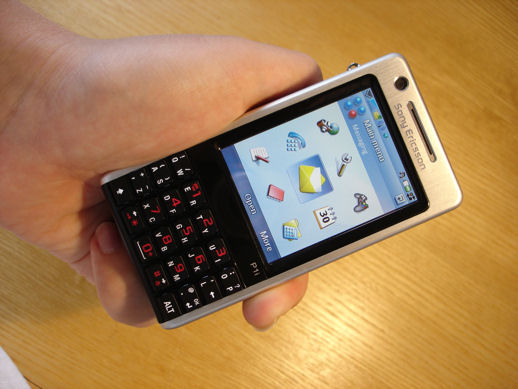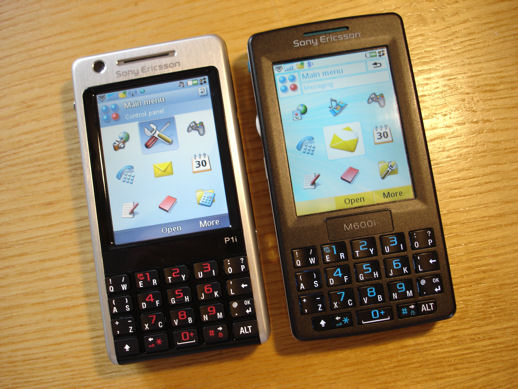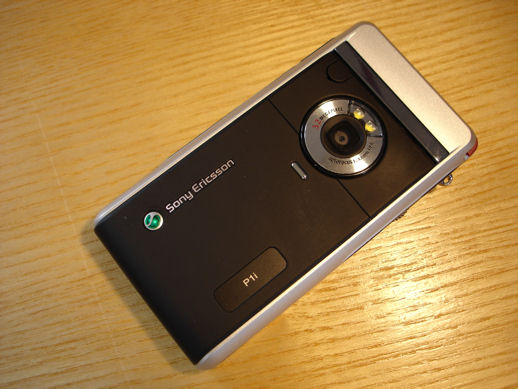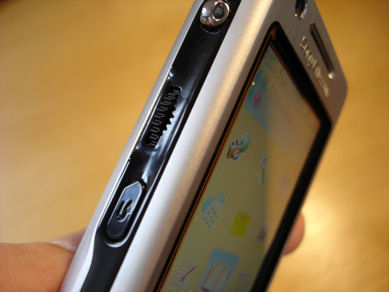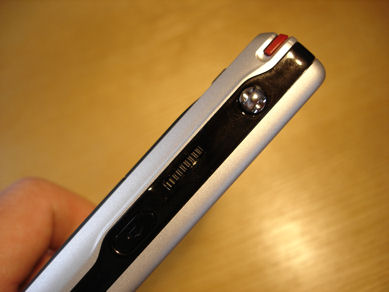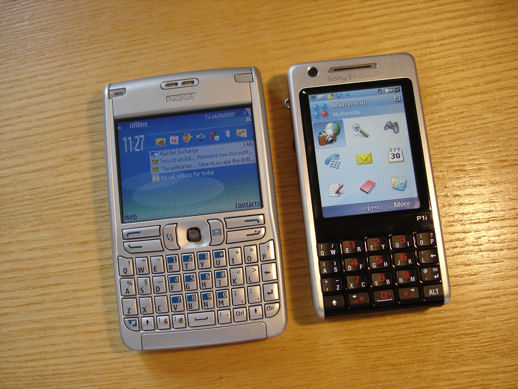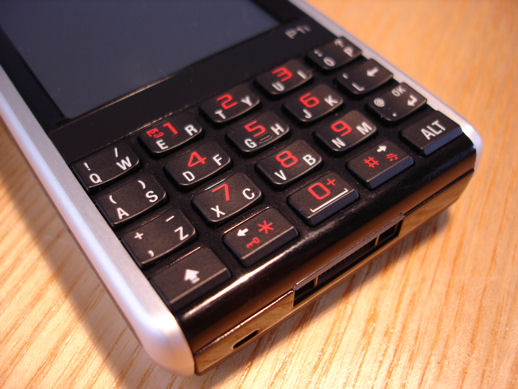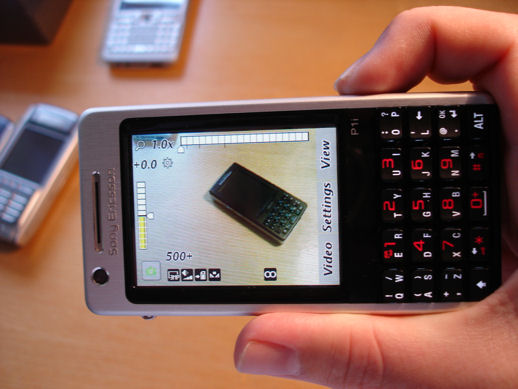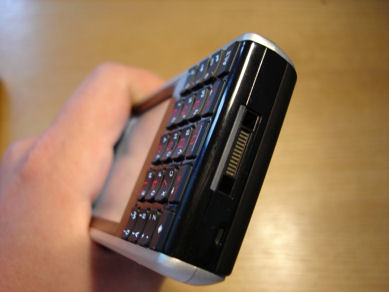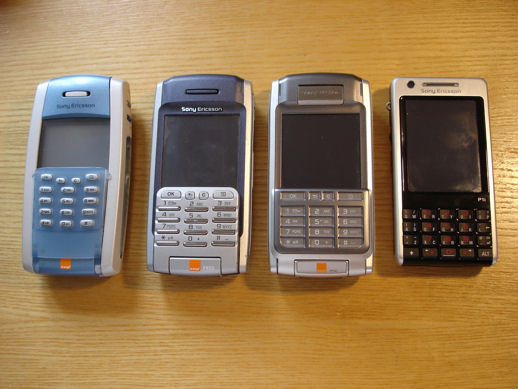Review: Sony Ericsson P1i - part 1: design and hardware
The P1i is Sony Ericsson’s new flagship smartphone product. Running the touchscreen variant of UIQ 3.0 on Symbian OS 9.1, with WCDMA, GSM and Wi-Fi connectivity, a QWERTY keyboard or handwriting recognition for text input and a 3.2 megapixel camera, it is well specified and a powerful smartphone.
The P1i uses the same UIQ 3 software platform as the P990 and there are relatively few software differences between the two phones. However, the P1i has double the RAM of the P990 and this has important implications for software operation and stability which we will discuss more fully in the second part of this review. In this first part of the review we concentrate on the hardware which has also had a very significant overhaul.
Overall Design
Although the P1i is the latest in the venerable P series of phones, a family ancestry which stretches back to 2002, it represents something of a departure from its predecessors. Whereas its earlier incarnations all featured optional flips (featuring numeric keypads) and a flip closed software mode which offered a subset of the phone's software functionality, the P1i presents a form factor more closely related to Sony Ericsson’s M600 communicator. The P1i takes the form factor and styling of the M600 and combines it with the hardware features of the P990i and adds a number of significant improvements of its own.
The obvious result of the form factor change is a significant size reduction, previous P series devices have tended to be on the chunky side. At 106 x 55 x 17 mm the P1i is a comfortable, pocketable size, and compared to the P990 (114 x 57 x 25 mm) is nearly 33% thinner. Managing to squeeze the form to this extent is a considerable achievement and, while the P1i remains relatively heavy at 125g, this is 25g less than the P990i and it retains the pleasing sense of solidity which is sometimes missing in competing devices.
The unique form factor of the earlier P series definitely has its fans, with flip closed mode offering an excellent one-handed experience. However, the reduction in size, in my opinion, should easily outweigh the lack of a flip for most people.
The P1i uses a subtly different implementation of UIQ 3 to the P990 - SoftkeyStyleTouch versus PenStyle - it's now better suited to one handed usage. From the screenshots below you can see some of the differences between the SoftkeyStyleTouch (P1i) and PenStyle (P990) implementations of UIQ 3. You will note that the status bar and on-screen 'back' key move from the bottom to the top and that that action/command softkeys are always found on the bottom of the display. The main menu is accessed via the 'More' softkey as opposed to a drop down menu from the top of the screen.


P990i (PenStyle) and P1i (SoftkeyStyleTouch)
The P1i screen is marginally smaller that the P990i, but its quality has been markedly improved with much better performance outdoors in sunlight.
The P1i is much sleeker than previous models, owing more to the styling found in Sony Ericsson’s range of feature phones. The materials used in the case are a combination of brushed aluminum (framing the front and sides), a hard shiny plastic (front face and keyboard) and a hard rubber material (rear and battery cover). The overall build quality is excellent and the materials have been intelligently placed. The rubber material on the rear of the device improves grip when holding the device, especially when using the keyboard for two handed text entry.
The back of the device houses the main 3.2 megapixel auto-focus camera along with a dual LED flash. The camera lens is slightly recessed into its housing, providing some limited protection. The right hand side of the device features the camera capture button, the memory card slot and the internet key. By default, this key is configured to launch the Web browser but this can be changed in Control panel. For power users the most useful configuration is to set this as a shortcut to the task manager, so as to enhance multi-tasking functionality.
The left hand side of the P1i features the two principal navigation controls – the scroll wheel and the 'back' key. P990 users may notice the absence of the hardware lock key and the multimedia key (play/pause media) - for manufacturers, there is always a balance to be drawn between simplicity, utility and costs. In this case, I think the correct decision has been made. The key lock can be activated by a long press on the back key and multimedia controls are generally more conveniently located on headsets.
Keyboard and data input
The P1i, like the P990i, has a full QWERTY keyboard at the bottom of the screen. However, the P1i’s keyboard, as with the rest of its styling, owes much more to the M600 than to its immediate P series predecessor. The P990i’s keyboard was cramped with small keys which was uncomfortable to use for prolonged periods. By contrast the P1i keyboard eschews the 'key for each letter' approach and instead uses a layout of 20 keys with the top 15 keys pivoting for a key press on the left and right side of each button. Each of these pivot keys therefore effectively operates as two keys. The usual QWERTY layout is preserved, with each letter sharing a key with another letter (for example the top right key serves both O and P). This layout is further refined by the use of a shift for capitalisation and an ALT key to access numbers (the central keys), punctuation and various symbols. Although this sounds rather convoluted, it works very well in practice and the larger keys mean that typing is more accurate (especially for those with larger hands). It also allows the P1i to be narrower than other phones with fully QWERTY keyboards - this is readily apparent when comparing the P1i and devices like the E61 side by side.
The intelligent predictive text software, provided by Zi Corporation and as found on Sony Ericsson’s other UIQ 3 phones, is a welcome presence. During typing, suggestions are displayed across the top of the screen – you can accept the current suggestion by pressing the return key or scroll through the other suggestions using the arrows keys that flank the spacebar key. The improved speed of the QWERTY keyboard makes this less significant than before, but it does offer a further refinement and speed boost for those willing to take advantage of it.
Compared to the P990, the P1i’s keyboard is a revelation – it is less fiddly to use and, although it does take a little longer to get accustomed to the keyboard’s operation, this is amply rewarded by higher input speeds. This, together with the absence of a flip and some software tweaks, makes the P1i much more usable as a one handed device. For those who prefer pen input, the P1i includes the same handwriting recognition as its predecessors and it is possible to achieve reasonable speeds once you become familiar with the system. The dual system may seem like overkill, but it is more of mark of the P1i’s flexibility. Though I imagine the majority of text input will be carried out using the hardware keys, some text input tasks, such as making corrections or highlighting text for copying and pasting, are easier to carry out using the stylus. The predictive text software is also easier to use in handwriting mode and provides a speed boost of around 10% during longer text entry.
Memory and Connectivity
The P1i has 160MB of internal flash memory (up from 60MB in the P990) which gives plenty of space for applications and basic contact and PIM data. Multimedia files will be best stored on a memory card using the P1i’s M2 (Memory Stick Micro) card slot, which supports card sizes of up to 4GB.
With Wi-Fi, WCDMA and GPRS, the P1i has a good range of connectivity options. Internet (data) accounts can be set up using any connection bearer and any access point can be included in a group. Improved from earlier UIQ 3 phones is the Settings Wizard, which now automatically recognises when a new SIM card has been inserted and offers the user the opportunity to download the appropriate data settings for internet and MMS usage.
A group consists of a prioritized list of internet accounts and can be used as the default internet account by many applications (effectively allowing multiple access points to be used without changing applications settings). Wi-Fi usage is straightforward with a simple scan and connect applet, accessible from the P1i’s drop down system menu or via Control panel. Internet accounts can be created for regularly used Wi-Fi access points and included in groups. Moreover, the special 'Default WiFi' internet account (which represents any current Wi-Fi connection) also allows one off Wi-Fi connections (e.g. at an airport) to be used within groups. This functionality, together with groups, means that the P1i will switch seamlessly between using Wi-Fi and cellular connectivity, offering cost savings and easier access to faster Wi-Fi connectivity.
Unfortunately, the P1i supports neither EDGE nor HSDPA (3.5G) data connections. The lack of EDGE is a concern for US users, who are also unable to use the WCDMA connectivity since the phone supports only European 3G bands. HSDPA is becoming more commonplace in high end phones and is supported by a large number of operators. Given the P1i’s rich application capabilities it is a shame that HSDPA connectivity, with its faster download speeds, is missing.
Camera
The P1i has a 3.2 megapixel auto-focus camera which is a small improvement compared to the P990i. The camera software is based on the same UI found in Sony’s Cybershot digital cameras and as such stands out as a little different from the rest of the phone. The interface can be overwhelming at first and the number of options and layout can be a bit unwieldy, but this is significantly improved by use of keypad (1-9) shortcuts, which are well worth learning. As with all camera phones, performance varies depending on conditions. Some photos can be a little grainy, especially in lower light conditions, but general point and click performance is good. Improved results can be obtained if the numerous settings are fully utilized.
The usual white balance, night mode, self timer and digital zoom modes are all present. The digital zoom mode is more useful that on other phones since it sensibly shrinks down the resolution (effectively cropping a larger photo) as you zoom rather than artificially maintaining high resolutions. Thanks to a dual LED flash, the P1i performs better in low light conditions compared to those phones with a single LED flash, although the illumination distance is still relatively limited. Video performance is average, with a maximum resolution of 320 x 240 at 15 frames per second. In general, camera performance is good, though it does not measure up to phones like the Nokia N95 or Sony Ericsson’s own high end Cybershot phones, such as the K850, which have better optics. Still, the camera should be good enough for the majority of users and, given the cost of improved optics and additional megapixels, it is a good compromise between performance and price.
Sample Images from the Camera (click through for full resolution):
Other design touches
There are a number of smaller touches that reflect the thought that has gone into the P1i’s design. An example of this is the LED powered light strip on one side of the connector port on the base of the phone. This illuminates during charging, but will also flash when there are unacknowledged new messages (email or SMS) waiting for you.
On the downside, the P1i uses Sony Ericsson’s proprietary connection port. The lack of a 3.5mm audio jack stifles the multimedia abilities of the phone. While USB charging is a welcome feature, the use of a proprietary cable lessens its usefulness.
In the retail box there is the usual USB cable, charger and headset, but there is also a desktop stand. You can connect the USB cable to this stand and it will also charge the phone if you have USB charging enabled on the phone. The benefit of this is you can effectively have two charging points for the phone out of the box. The stand also makes PC connectivity a breeze and gives a good home station for your phone. There is also a slip case for the phone, providing protection against day to day scratches. These extras reflect the excellent overall value of the P1i. The initial pricing is competitive, the onboard software bundle is good and the hardware extras are a nice touch. This is further extended in certain markets with additional extras in the box – some European countries will get a Bluetooth GPS and a year's subscription to Wayfinder (navigation software) while some Asian countries include a software voucher (with a rough value of $100).
Conclusion
The P series of phones from Sony Ericsson has traditionally been the most effective true marriage of traditional PDA and phone into a single device. The hardware design on the P1i continues that trend. The smaller size makes the device much more pocketable, while the improved keyboard, especially in light of its size, provides one of the best data entry experiences available. The combination of touchscreen and one handed usage, together with the UIQ software platform, does means there is a necessary learning curve, but it consequently also gives the P1i a great deal of flexibility.
There is room for hardware improvements; Sony Ericsson risk being left behind by not including HSDPA and EDGE connectivity, the use of proprietary connectors is old fashioned and those with larger hands may find the keyboard frustrating.
The temptation of adding new features to high end phones can be difficult to resist, but such new features take time to mature and can add an unnecessary level of complexity for the majority of users. Sony Ericsson have clearly looked at what their core users need from the phone and built the P1i to meet these specifications. As a result the P1i is not as cutting edge as some of its predecessors, but it is a more mature, stable piece of hardware. The design represents a significant improvement over its predecessors for the majority of users. The reduction in size, build quality, materials used and keyboard are particular highlights. While it may not excite those who want to see cutting edge technologies included (who might be well advised to wait patiently for future releases), the P1i is an extremely capable phone which offers an excellent real world usage experience.
Rafe Blandford, All About Symbian, 14 August 2007
The Sony Ericsson P1i is widely available in web stores, such as Clove Technology, and will be available with select operators in due course.
Reviewed by Rafe Blandford at

